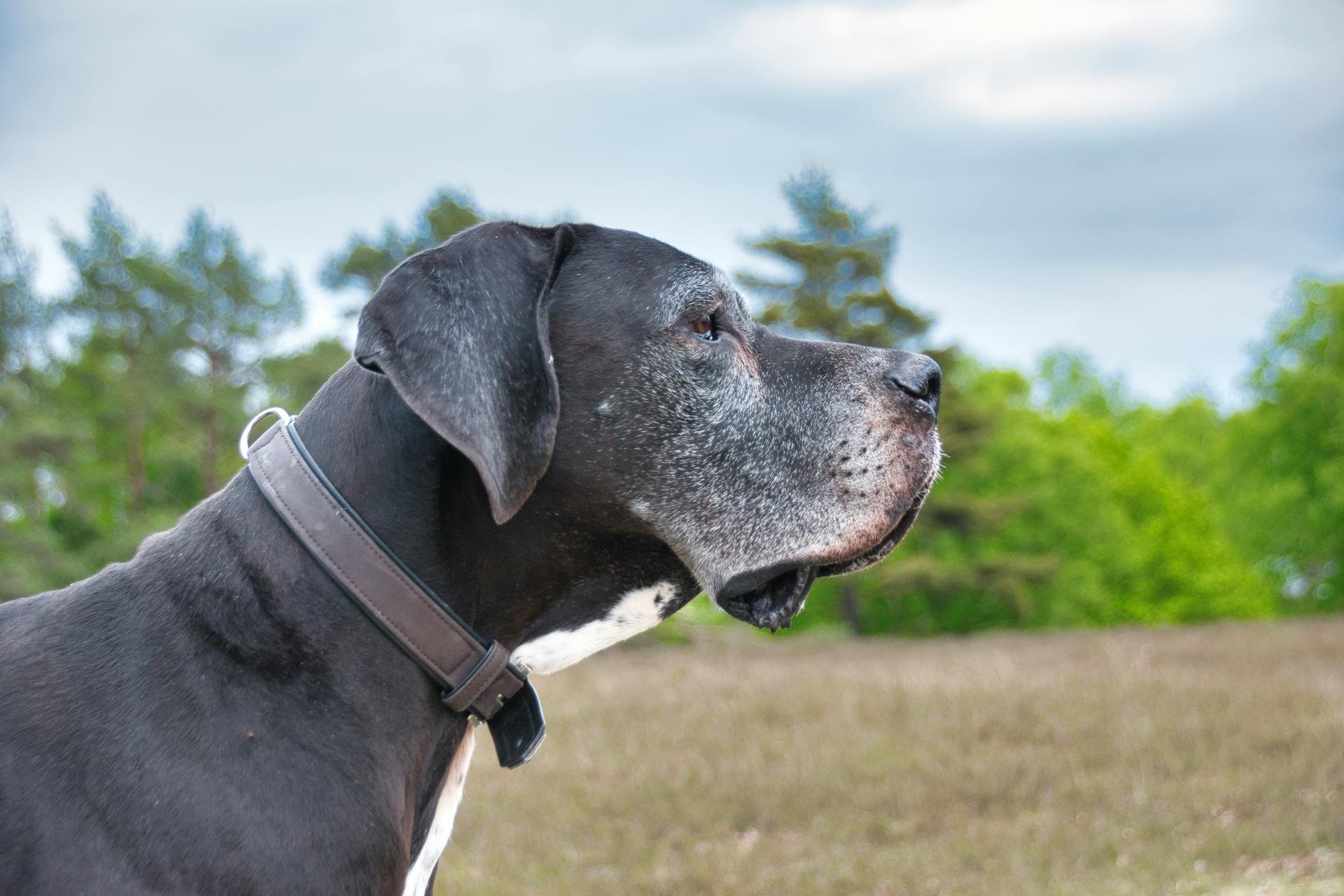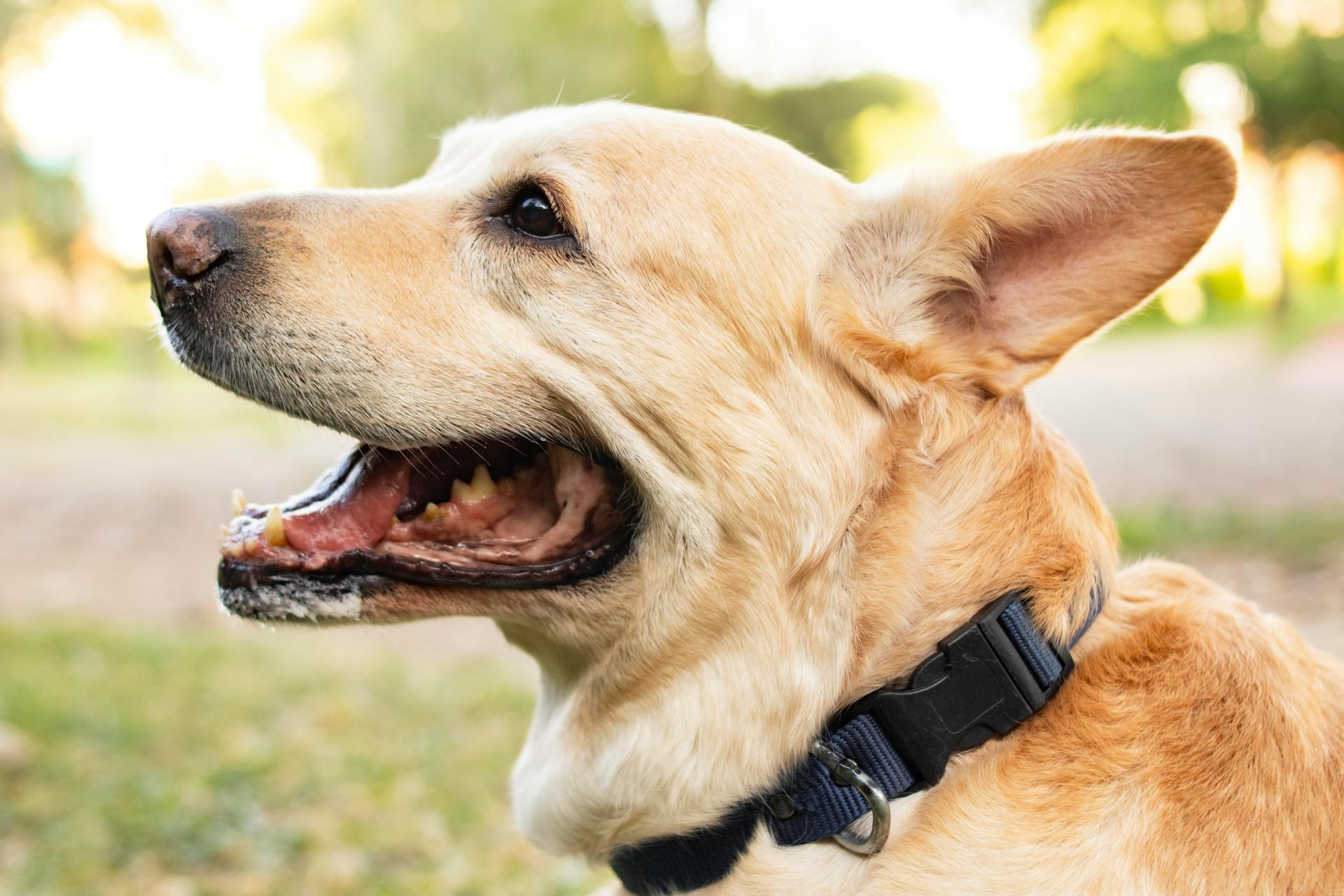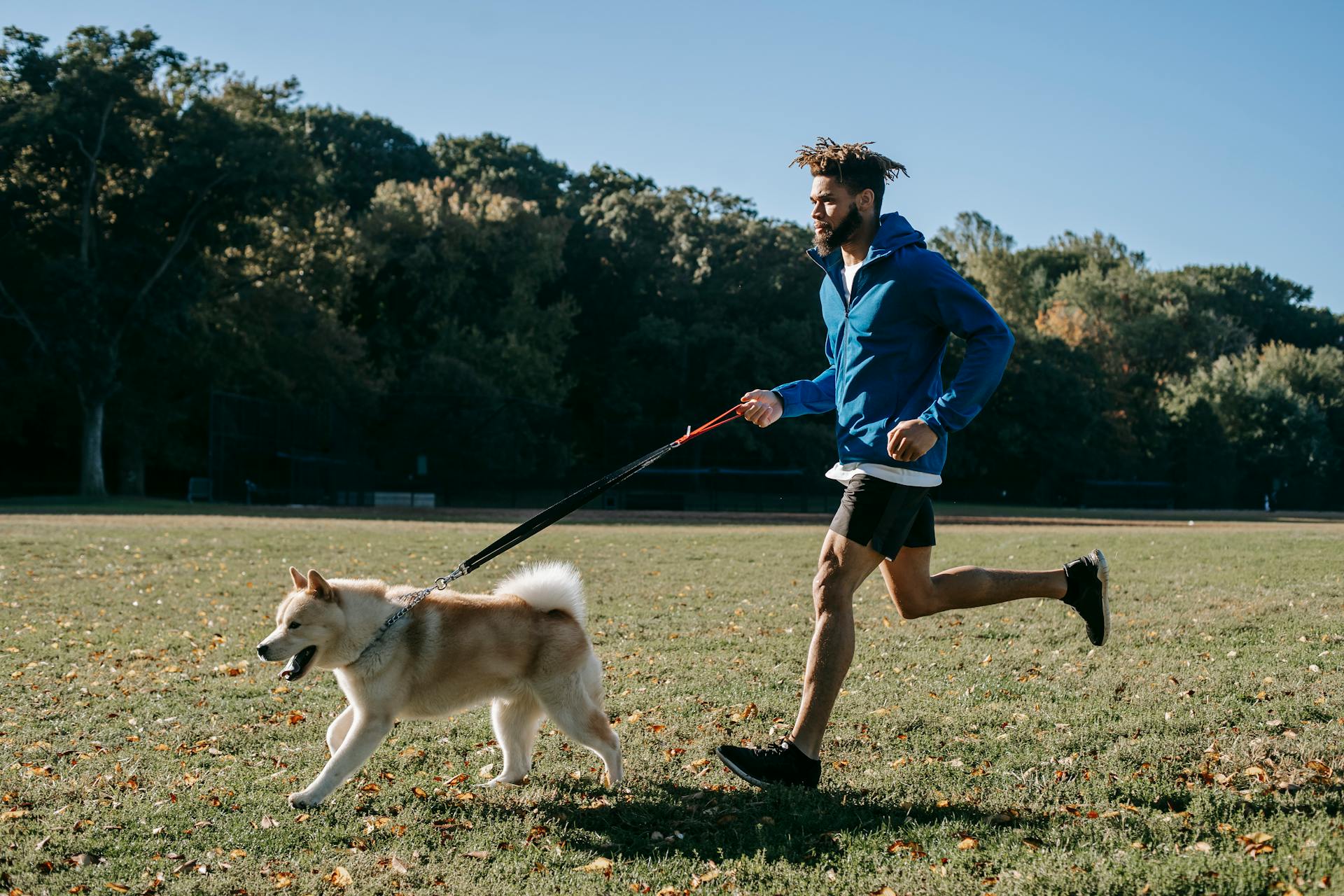
A bark collar is a device worn by a dog to help reduce excessive barking. It's a simple yet effective solution for dog owners who struggle with their pet's incessant barking.
There are several types of bark collars available, each with its own unique features and benefits. Some are designed for specific breeds or sizes of dogs.
One common type of bark collar is the spray collar, which releases a harmless spray when the dog barks. This can be an effective way to deter barking, especially for dogs that are sensitive to noise.
Some bark collars also use vibrations or shocks to discourage barking, but these should be used with caution and under the guidance of a professional trainer.
What Is a Bark Collar
A bark collar is a device that helps to curb excessive barking in dogs. It's a humane way to address barking issues, unlike yelling or punishing your dog.
Bark collars can be triggered by the dog's own barking, or by a specific sound or motion. They work by emitting a harmless but unpleasant stimulus, such as a beep or a vibration, to interrupt the barking behavior.
Some bark collars are adjustable, allowing you to customize the level of correction to suit your dog's needs. This is especially useful for dogs with varying levels of sensitivity.
Bark collars are not a substitute for proper training and socialization, but they can be a valuable tool in helping to address barking issues.
Types of Bark Collars
There are four main types of bark collars: static, vibration, sound, and spray. Each type works in a unique way to deter barking.
Static bark collars release a low-level shock to stop barking, but vibration collars use a vibrating pulse instead, making them a safer alternative. Some vibration collars have multiple stim levels that are adjustable.
Sound bark collars use an ultrasonic or beeping sound to distract the dog, while spray collars release a burst of spray to interrupt barking behavior. The spray is harmless to dogs, but some may be allergic to the ingredients.
Some collars feature a combination of types, such as static and vibration modes, giving pet owners flexibility in choosing the right stimulation for their dog.
Take a look at this: Vibration vs Shock Collar
Ultrasonic Devices
Ultrasonic Devices are a great option for those who want to deter barking without using static or vibration. They produce high-pitched sounds in response to barking, which can be annoying for dogs but inaudible to humans.
These devices can be used both indoors and outdoors and can detect barking from any dog within range. This makes them a great solution for households with multiple dogs or for those who have noisy neighbors.
To use an ultrasonic device effectively, it's essential to consult with a professional trainer for advice on your individual dog. They can help you determine the best placement for the device and ensure it's set up to work correctly.
The device should be facing your dog, and your dog must be within the detection area of the machine's microphone. Keeping the area between the dog and the device clear is also crucial to ensure the ultrasonic noise can reach your dog.
It's also worth noting that ultrasonic devices can be used to prevent barking competitions between dogs in neighboring yards. However, if you have multiple dogs and only one is a nuisance barker, be aware that all dogs will receive the device's correction.
Related reading: How to Get a Great Pyrenees to Stop Barking
Spray
Spray bark collars are a type of bark deterrent that emits a spurt of air or citronella when they detect a bark. This can be a great option for dogs that are easily distracted by noise and smell.
These collars work by emitting a hissing sound and a blast of spray, which can be very annoying for dogs. The citronella smell can also be overwhelming for some dogs.
To use a spray bark collar effectively, it's essential to consult with a professional trainer for advice on the device and your individual dog. They can help you determine the best settings and usage for your dog's specific needs.
The PetSafe Elite Little Dog Spray Bark Collar is a top pick for spray bark collars, with a compact and lightweight design that's suitable for small dogs. It holds 30-40 sprays per refill, which can last for a while, especially for less frequent barkers.
You'll need to refill the collar regularly, especially if your dog barks frequently, as it can only hold so many sprays at a time.
Here's an interesting read: Citronella anti Bark Collar
Types of Bark Collars
There are several types of bark collars available, each with its own unique features and benefits.
Some bark collars use static correction, which can be a powerful tool to help teach your dog sound commands.
Static bark collars are often used in conjunction with other training methods, especially when owners feel like they haven't been getting the results they want.
There are also different types of static bark collars, such as those with programmable training modes.
The SportDOG NoBark SBC-R, for example, offers three programmable training modes: Temperament Learning, Progressive Correction, and User-Selected.
These modes allow owners to tailor the training to their dog's specific needs and personality.
Here are the three training modes offered by the SportDOG NoBark SBC-R:
Choosing a Bark Collar
To choose the right bark collar, you need to consider your dog's temperament and needs. This is because different breeds, like Beagles and Chihuahuas, may require specific types of collars.
A bark collar should be tailored to your dog's weight and neck size. This ensures a comfortable fit and effective correction.
When selecting a bark collar, look for reputable companies that adhere to e-collar industry guidelines. This guarantees a safe and reliable product.
Here are some key features to consider when choosing a bark collar:
- The type of collar suited for your dog's temperament and needs
- A collar tailored for your dog concerning weight and neck size
- Manufactured by reputable companies, adhering to e-collar industry guidelines
- Have safety features to avoid overcorrection
- Have adjustable levels and flexible correction modes
- Accurate in detecting your dog's barking, filtering ambient noises
- Waterproof and rechargeable
- Cost-effective that fits your budget
Other Methods
There are other kinds of bark control methods beyond what we've discussed, and it's worth noting that some of these methods can be effective, but it's always a good idea to consult with a professional trainer before trying them out.
Static correction is one such method, but we recommend exercising caution with it.
Choosing a Product for My Dog
First, consider your dog's temperament and needs when selecting a bark collar. This will help you choose the right type of collar for your dog.
The weight and neck size of your dog are also important factors to consider. Most bark collars have a weight restriction, and puppies under 8 pounds should not use a no-bark collar. Some collars are designed for small dogs like Pugs, but not for large breeds like Great Danes.
Recommended read: Training a Dog Not to Bark
Before shopping, measure your dog's neck size by wrapping a tape measure around their neck snugly, not too loose but not too tight. Compare this measurement to the sizing chart of the brand you're considering.
Manufacturers also have different types of bark collars, such as static, vibrating, sound, and spray collars. Some collars are adjustable, with flexible correction modes, while others are not.
Here are some key features to look for in a bark collar:
- Adjustable levels of stimulation
- Flexible correction modes, such as auto, user-select, progression, and temperament learning modes
- Accurate bark sensor technology or a false-trigger feature to prevent false corrections
- Waterproof and rechargeable design
- Safety features to avoid overcorrection
- Cost-effectiveness that fits your budget
By considering these factors and features, you can choose a bark collar that is tailored to your dog's needs and helps you achieve your training goals.
No Work Policy
Some bark collars work automatically, sending a negative stimulus once your dog barks, without needing constant supervision. This is a huge advantage for busy owners.
Most anti-bark collars deliver the stimulation automatically, but some require a handheld remote, which can be a problem if no one is around to control it.
The stimulation level can be adjusted, with some collars increasing it until your dog stops barking, while others allow manual adjustment to start at a level where your dog will react.
For Medium to Large Dogs
For medium to large dogs, a bark collar with advanced features is a must. The Dogtra YS600 is a great choice for dogs 35 pounds and above.
This collar comes with a highly accurate Accelerometer Bark Sensor that filters outside noise to prevent false corrections. It's fully waterproof, making it perfect for outdoor use.
The Dogtra YS600 also has a vibration option, giving you an alternative to static corrections. This is a great feature for dogs that are sensitive to shock.
The collar's Persistent Bark Indicator shows you the number of times your pet has barked, helping you decide if you need to adjust the correction level. This feature is especially useful for owners who want to monitor their dog's behavior.
Discover more: Do Bark Collars Work on Great Pyrenees
Safety and Effectiveness
Safety is a top priority when it comes to bark collars. Only consider anti-bark collars from reputable manufacturers or those that adhere to industry guidelines for the proper usage of electronic training tools.
A safety mechanism is a must-have in modern bark collars. They are programmed to issue the correction for a limited time, automatically stopping the stimulation once the time lapses.
Reputable brands offer long warranty periods for repairs and returns, so you can have peace of mind in case something goes wrong. Good customer service support is also essential, indicating that the company is devoted to resolving any issues or inquiries you may have.
Some bark collars are more effective than others, but they are generally reliable and effective. They can detect not only your dog's actual barking but also their howling and whining, thanks to their ability to detect the vibrations of your dog's vocal cords.
To ensure the collar works properly, make sure it fits snugly around your dog's neck. This will deliver the stimulus whenever your dog barks, and you won't have to worry about the collar's effective range.
Are Effective?

Bark collars are reliable and effective, as you won't have to watch over your dogs to ensure the collar works.
The effective range of the collar is not a concern, as long as your dog is wearing it.
Some anti-barking devices detect the vibrations of your dog's vocal cords, identifying not only their barking but also their howling and whining.
To ensure the collar works properly, it's essential to make sure it fits snugly around your dog's neck.
Safety
Safety is a top priority when considering a no bark collar. Only consider anti bark collars from reputable manufacturers or those that adhere to industry guidelines for the proper usage of electronic training tools.
Modern bark collars have a safety feature to avoid overstimulating your dog. This feature is programmed to issue the correction for a limited time, then automatically stops. The correction will only resume after a certain time and if your dog barks again.

Warranty is another important aspect of safety. Reputable brands offer long warranty periods for repairs and returns.
Good customer service support is also a sign of a company's commitment to safety and effectiveness. It indicates that the company is devoted to resolving any issues or inquiries a customer may have about their product.
Here are some key safety features to look for in a no bark collar:
- Safety Mechanism: A limited-time correction that stops automatically.
- Warranty: A long warranty period for repairs and returns.
- Customer Service: Good support for resolving any issues or inquiries.
Don't rely heavily on online product reviews, as companies may manipulate them to influence buyers' decisions.
Product Reviews and Recommendations
If you're in the market for a bark collar, you've got options. The PetSafe Lite Rechargeable Bark Collar is perfect for small and timid dogs, weighing 8 pounds and up.
This collar features a smaller design and milder stimulation than standard versions, making it a great choice for sensitive pets. It also has built-in temperament learning, which adjusts the correction level based on your dog's behavior.
For dogs of any size, the SportDOG NoBark SBC-R is a solid option. It offers three programmable training modes: Temperament Learning, Progressive Correction, and User-Selected.
Here are some key features of the SportDOG NoBark SBC-R:
The SportDOG NoBark SBC-R is also waterproof, submersible up to 10 feet, and has a battery that lasts 200 hours per charge.
PetSafe Elite Little Dog Spray
The PetSafe Elite Little Dog Spray Bark Collar is a great option for pet owners who want a spray anti-barking device. It's designed to be compact and lightweight, making it perfect for small dogs.
This collar has a built-in sensor that detects both vibration and sound before spraying, so you won't have to worry about false corrections. This means you can trust that the collar is only responding to your dog's barking, not other noises in the environment.
The PetSafe Elite Little Dog Spray Bark Collar holds 30-40 sprays per refill, with 300-400 sprays available per can. This means you'll need to refill it regularly, especially if your dog is a frequent barker.
The collar is also waterproof, making it a great option for rainy days or dogs that love to swim.
On a similar theme: Sit Means Sit Dog Training Collar
BP-504 Pro by E-Technologies
The BP-504 Pro by E-Technologies is a highly effective training collar that deserves some serious consideration. It's designed to detect your dog's barking, howling, and whining.
This collar allows you to choose from three training modes: Auto-Mode, Manual Mode, and Tone-Only. With Auto-Mode, the correction level changes automatically depending on the level of barking.
The BP-504 Pro also features a bark counter, which keeps track of your dog's barking behavior. It's fully waterproof and shock-resistant, making it a durable and dependable option.
It's worth noting that the BP-504 Pro is a top-notch product from a reputable brand.
Additional reading: Pro Educator E Collar
Profits
Using a bark collar can be a great way to reduce excessive barking and create a quieter environment for both you and your neighbors. By teaching your dog to associate an unpleasant sensation with barking, you can significantly reduce the behavior.
The range of correction methods offered by bark collars is one of its key advantages. These can include sound, vibration, or mild static stimulation, allowing you to choose the most suitable option for your dog's temperament, size, and sensitivity.

With a bark collar, you don't need to be present for it to work. This is a major convenience for busy individuals who may not always be able to supervise their dog.
Here are five notable advantages of using a bark collar:
- Reduced nuisance barking
- Tailored corrections
- Versatility in training
- Remote-free operation
- Improved communication
By choosing the right bark collar and training method, you can establish clear boundaries and expectations for your dog, leading to a stronger bond and a more harmonious living environment.
Frequently Asked Questions
What does a bark collar do to a dog?
A bark collar uses a physical distraction, such as vibration or a mild shock, to discourage barking. It doesn't harm your dog, but rather helps to train them to stop excessive barking.
Do vets recommend bark collars?
Vets generally do not recommend bark collars as a first choice for addressing barking issues, especially those driven by fear, anxiety, or compulsion. Instead, they often suggest exploring alternative, more humane solutions to address the underlying cause of the barking.
What's the difference between a bark collar and a shock collar?
A bark collar uses sound, vibration, or mild static stimulation to correct barking, while a shock collar specifically uses static stimulation as its primary correction method. The main difference lies in the correction method, with bark collars often considered a more humane option.
How long does it take for a bark collar to work?
The time it takes for a bark collar to work varies from dog to dog, typically ranging from a few days to several weeks, depending on proper use and training. Effective results may be achieved sooner with consistent and correct usage.
What triggers a bark collar?
A bark collar is triggered by the vibration of your dog's vocal cords, which is detected when they bark. This detection sends a low-level shock to the dog's neck, aiming to stop the barking behavior.
Sources
- https://www.akc.org/expert-advice/training/bark-control-tools-to-help-stop-nuisance-barking/
- https://www.edogaustralia.com.au/blogs/edog-lets-us-help-you-train/static-bark-collars-the-myths-debunked
- https://petspy.com/blogs/dog-training/difference-between-bark-collar-and-training-collar
- https://petstek.com/blogs/petstek-blog/beginner-guide-to-choosing-the-right-bark-collar-for-dogs
- https://www.k9control.co.nz/bark-collar-faqs-2
Featured Images: pexels.com


